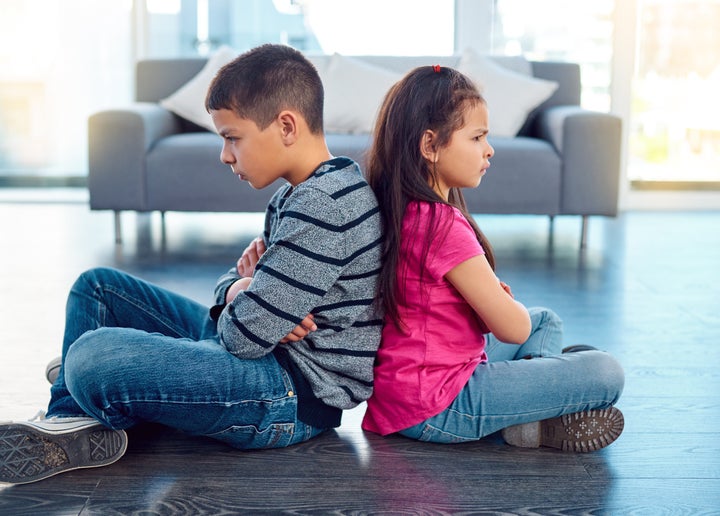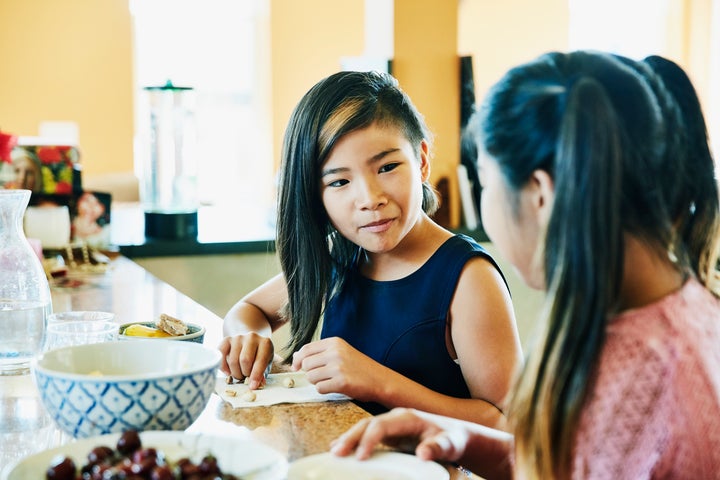
In the era of remote learning and social distancing, children are missing out on opportunities to develop important interpersonal skills. The decline in socialization in 2020 means they’ve been getting less practice with problem-solving, communication and other types of social-emotional learning.
One particularly important skill that needs work: the art of disagreeing.
“When kids learn to disagree without resorting to an explosion or a tantrum, they develop crucial skills for having friendships that don’t fall apart and for being part of a creative team with peers on any projects, sports, leadership committees, or clubs that they want to join,” said Leonard Felder, a licensed psychologist and author of “We See It So Differently.”
“Knowing how to listen calmly with respect and then to brainstorm on solutions that include all the points of view is something that kids definitely can learn, but it takes practice and gentle guidance on how to cool down the fierce ‘I’m right and you’re wrong’ feelings that flare up in all of us,” he added.
As we’ve seen clearly in recent years, disagreements are a part of everyday life. It’s important to learn how to discuss differing opinions and preferences (assuming they do not deny basic humanity and reason) without resorting to dismissiveness, name-calling or cruelty. Doing so promotes independent thinking, identity formation and understanding of others.
But in the absence of a traditional classroom and playground interactions, how can kids learn to express opinions, communicate effectively, navigate disagreements and work together to problem-solve? Below, Felder and other experts share their advice for parents who want to teach their children how to disagree in a healthy way.
Start early.
Learning to disagree is a lifelong process that begins with basic foundational skills like empathy and communication. Don’t think of this as a single lecture but rather a series of conversations and experiences.
“From an early age, we teach children to share, be polite, be a good sport,” noted Robin Goodman, a clinical psychologist and art therapist who works with children. “These are great building blocks for good communication and getting along with other people.”
Talk about feelings.
“Helping kids understand their feelings when conflict arises is extremely helpful,” Goodman explained. “For example, are they feeling hurt, left out, frustrated, not listened to, misunderstood, or embarrassed? Putting words to the feelings can help understand what is going on and the source of the issue rather than it just being about a disagreement.”
Helping kids understand and express their emotions can empower them to handle conflict and disagreement. Make a daily habit of talking about feelings.
“The feelings are important because you also need to help a child with what to do when they feel embarrassed or angry rather than just focusing on the actual words they disagree with,” Goodman said.
Cultivate empathy.
As kids learn to understand their own feelings, they can start to recognize those emotions in others and develop empathy. Empathy and emotional intelligence are skills you can cultivate every day, like exercising a muscle in the body with daily exercise.
“Ask your child to put themselves in someone else’s shoes, challenge them to ask questions like, ‘Why did they say that? How would I feel if I was left out? How could I have said that differently? What do you think they were feeling and thinking?’” suggested psychologist, play therapist and “Mommy Burnout” author Sheryl Ziegler. “Gaining empathy is a great skill for effective communication, improving relationships and enduring difficult times.”
“It’s about understanding, not proving you’re right. Take time to understand and to listen to the answers. Help children with how to ask questions and learn more ― I think of it as helping children to be curious about what the other person is thinking and why.”
- Robin Goodman, clinical psychologist and art therapist
In the context of a disagreement, empathy doesn’t mean you have to back down from your position, but it helps you manage the clash respectfully. It’s about understanding that people are different and hold different views for a variety of reasons.
“It doesn’t mean the person is right ― just that you at least understand, or consider their perspective,” Goodman said. “This goes along with helping your child not assume what the other person was thinking or doing but rather finding out more. Teaching kids to disagree is also about learning from others. They may have ideas and knowledge that you don’t have, so listening and learning can actually be helpful.”
Lead by example.
“Watch out for how you disagree with partners and friends as your children are watching and learning in real time,” Goodman advised. “If you disagree with someone, you may find a time when you can then explain what you did, or ask your child what they noticed about how you handled it. Of course parents don’t have to do it every time, but look for those teachable moments and examples.”
Parents can also model healthy disagreement in their interactions with their children and each other. They can do this by listening to the other person, considering their viewpoint, calmly expressing that they disagree and then either reaching a resolution or moving on.
“If you or your family create a regular habit of making sure that in a discussion, each point of view gets heard and each member of the team is part of the brainstorm conversation to come up with a way to honor and include each point of view, then these peacemaking skills will become second-nature to your kids,” Felder said. “On the other hand, if your family has a tendency to turn everything into a power struggle or a one-upmanship where the most angry or disruptive person dominates each time, then your kids will learn that intimidation and bullying are the ticket.”
Build listening skills.
“A significant amount of conflict arises from miscommunication,” said Sara Potler LaHayne, founder and CEO of the social-emotional learning provider Move This World. “Remind your kids what being a good listener looks like, including looking directly at the speaker, repeating for understanding, and asking questions rather than quickly jumping in with advice or interrupting.”
Podcasts and audiobooks offer another way for kids to develop listening skills.
It’s also important for parents to model good listening behavior in conversations with their children by making eye contact, confirming what the child said, and asking them clarifying questions, rather than making assumptions or rushing to judgment.
“It’s about understanding, not proving you’re right,” Goodman said. “Take time to understand and to listen to the answers. Help children with how to ask questions and learn more ― I think of it as helping children to be curious about what the other person is thinking and why. For young children, it may just be teaching them to take turns, that they don’t always have to go first, or that two people can both be right from their point of view.”

Identify coping strategies.
Disagreements evoke strong emotions, so it’s helpful to give kids a roadmap for handling those overwhelming feelings. Age-appropriate calming strategies include mindful breathing, journaling, drawing or other forms of creative expression.
“You can model and practice with your kids, ’When I feel no one is listening to me or no one is taking my ideas seriously, I usually take a few breaths and cool down my fire so that I can still be part of the conversation and not explode. Then I ask calmly and say, ‘I need some help here. Can someone help me find a solution that combines what I’m hoping for and what others are hoping for also?’” Felder explained.
Parents can also teach their kids problem-solving strategies like compromising, negotiating, and brainstorming and testing out different solutions. Children may practice these skills at home with their siblings as well.
Practice respectfully disagreeing.
When disagreements arise, parents can walk their children through the process and offer guidance. Encourage them to communicate their feelings and perspective by using “I” statements, like “I felt sad when I heard that” or “I believe this is what happened.”
“Teach children how to listen to another person’s idea without putting down the other person’s ideas and beliefs,” suggested Reena B. Patel, licensed educational psychologist, board-certified behavior analyst and author of “Winnie & Her Worries.”
“Teach them to not make or take disagreements personally,” she added. “Stay on topic and do not bring in another person’s character trait when making a point.”
“When children watch television or hear adults have conversations, they observe disagreements in action.”
- Reena B. Patel, licensed educational psychologist and board-certified behavior analyst
Rupa Mehta is the founder of Subject of Self, a free social-emotional learning curriculum for kids. She developed an exercise to teach little kids to disagree and debate, starting with small topics that get them comfortable reflecting on, expressing and listening to opinions.
“Ask your kindergartner whether they prefer chocolate or vanilla,” she advised. “Take a poll of everyone in your family, so your child can see that some people may have different answers and disagree on which is the ‘better’ flavor. Now take a trip to the freezer and do an inventory of your ice cream ― I imagine they will see an assortment of flavors that represent the different favorites of the people in their household, illustrating that even with disagreement, there can be harmony!”
Use media.
“Reading with your child is a great opportunity to discuss conflict resolution through literature,” LaHayne explained. “As you read together, you can ask questions like ‘What do you think this character is feeling? Why do you think they are feeling that way?’ You can also help your child relate the story or characters to themselves, asking questions like ‘Have you ever felt that way, too? Have you been in a similar situation before? If you were this character, what would you do?’”
She recommended “Rulers of the Playground” by Joseph Kuefler as a great picture book that emphasizes conflict resolution. With older children, you can talk about current events in the news ― different sides of the issue at hand, ways to find solutions and good or bad examples of disagreement.
“When children watch television or hear adults have conversations, they observe disagreements in action,” Patel said. “They are able to hear various sides and might even be creating their own opinions through these observations. This also helps with their self-confidence.”
Make it a family activity.
You can practice respectfully disagreeing and resolving conflicts as a family in informal settings.
“Make it into a fun game and say specifically, ‘Let’s see how we can come up with an activity or a schedule or a dinner plan or what to watch on TV that takes into account the wishes of each person here. It’s gotta be a solution that each person contributes to and feels good about. We can do this!’” Felder suggested.
“Kids are good at putting a jigsaw puzzle together,” he added. “In a similar fashion, the team project of peacefully including all the diverse viewpoints in the room is like putting a puzzle together where each of us has only part of the puzzle and needs the other parts to make it whole and complete.”
Be patient.
Again, developing the skills to navigate disagreements is a lifelong process. Don’t fret over heated arguments or other lapses in progress.
“If one of your kids ― or one of the adult members of the household ― has a lot of fire inside and needs extra patience and coaching to be able to cool that fire and be part of a cooperative team, that’s OK,” Felder stated. “Please encourage each small step of progress that this intense individual achieves and reassure this volatile person that some of the great minds and great creative forces also had to make small steps of gradual progress to learn to be heard, included and successful as part of a team.”